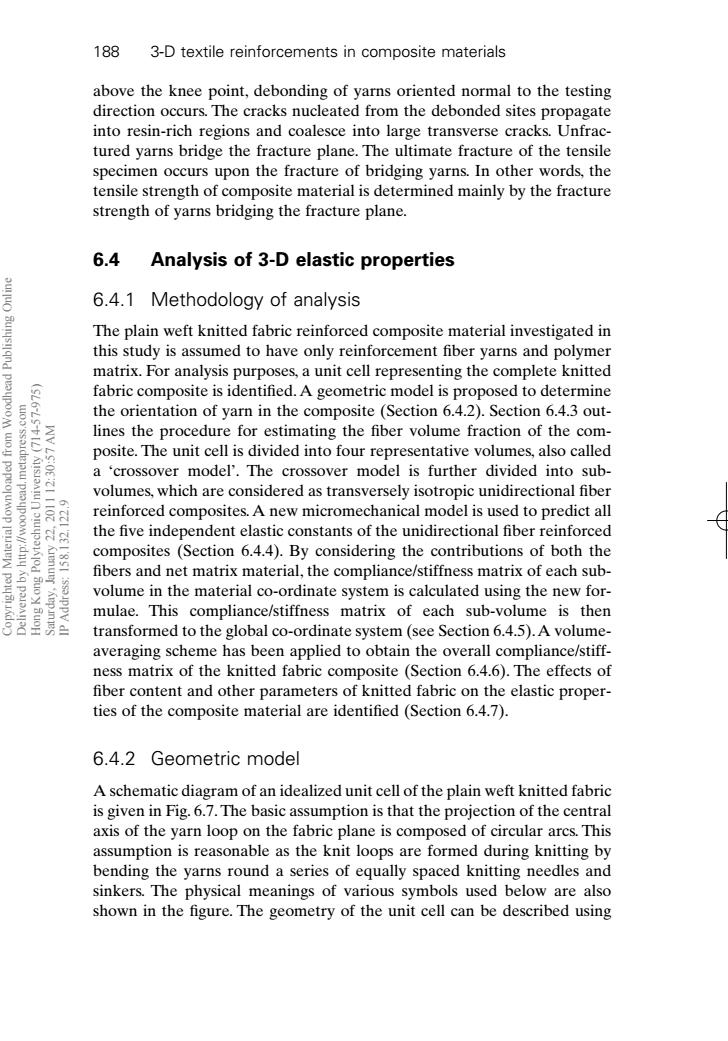正在加载图片...

188 3-D textile reinforcements in composite materials above the knee point,debonding of yarns oriented normal to the testing direction occurs.The cracks nucleated from the debonded sites propagate into resin-rich regions and coalesce into large transverse cracks.Unfrac- tured yarns bridge the fracture plane.The ultimate fracture of the tensile specimen occurs upon the fracture of bridging yarns.In other words,the tensile strength of composite material is determined mainly by the fracture strength of yarns bridging the fracture plane. 6.4 Analysis of 3-D elastic properties 6.4.1 Methodology of analysis The plain weft knitted fabric reinforced composite material investigated in this study is assumed to have only reinforcement fiber yarns and polymer matrix.For analysis purposes,a unit cell representing the complete knitted fabric composite is identified.A geometric model is proposed to determine the orientation of yarn in the composite (Section 6.4.2).Section 6.4.3 out- lines the procedure for estimating the fiber volume fraction of the com- posite.The unit cell is divided into four representative volumes,also called a 'crossover model'.The crossover model is further divided into sub- volumes,which are considered as transversely isotropic unidirectional fiber reinforced composites.A new micromechanical model is used to predict all the five independent elastic constants of the unidirectional fiber reinforced composites (Section 6.4.4).By considering the contributions of both the fibers and net matrix material,the compliance/stiffness matrix of each sub- volume in the material co-ordinate system is calculated using the new for- mulae.This compliance/stiffness matrix of each sub-volume is then transformed to the global co-ordinate system (see Section 6.4.5).A volume- averaging scheme has been applied to obtain the overall compliance/stiff- ness matrix of the knitted fabric composite (Section 6.4.6).The effects of fiber content and other parameters of knitted fabric on the elastic proper- ties of the composite material are identified (Section 6.4.7). 6.4.2 Geometric model A schematic diagram of an idealized unit cell of the plain weft knitted fabric is given in Fig.6.7.The basic assumption is that the projection of the central axis of the yarn loop on the fabric plane is composed of circular arcs.This assumption is reasonable as the knit loops are formed during knitting by bending the yarns round a series of equally spaced knitting needles and sinkers.The physical meanings of various symbols used below are also shown in the figure.The geometry of the unit cell can be described usingabove the knee point, debonding of yarns oriented normal to the testing direction occurs. The cracks nucleated from the debonded sites propagate into resin-rich regions and coalesce into large transverse cracks. Unfractured yarns bridge the fracture plane. The ultimate fracture of the tensile specimen occurs upon the fracture of bridging yarns. In other words, the tensile strength of composite material is determined mainly by the fracture strength of yarns bridging the fracture plane. 6.4 Analysis of 3-D elastic properties 6.4.1 Methodology of analysis The plain weft knitted fabric reinforced composite material investigated in this study is assumed to have only reinforcement fiber yarns and polymer matrix. For analysis purposes, a unit cell representing the complete knitted fabric composite is identified. A geometric model is proposed to determine the orientation of yarn in the composite (Section 6.4.2). Section 6.4.3 outlines the procedure for estimating the fiber volume fraction of the composite. The unit cell is divided into four representative volumes, also called a ‘crossover model’. The crossover model is further divided into subvolumes, which are considered as transversely isotropic unidirectional fiber reinforced composites. A new micromechanical model is used to predict all the five independent elastic constants of the unidirectional fiber reinforced composites (Section 6.4.4). By considering the contributions of both the fibers and net matrix material, the compliance/stiffness matrix of each subvolume in the material co-ordinate system is calculated using the new formulae. This compliance/stiffness matrix of each sub-volume is then transformed to the global co-ordinate system (see Section 6.4.5).A volumeaveraging scheme has been applied to obtain the overall compliance/stiffness matrix of the knitted fabric composite (Section 6.4.6). The effects of fiber content and other parameters of knitted fabric on the elastic properties of the composite material are identified (Section 6.4.7). 6.4.2 Geometric model A schematic diagram of an idealized unit cell of the plain weft knitted fabric is given in Fig. 6.7. The basic assumption is that the projection of the central axis of the yarn loop on the fabric plane is composed of circular arcs. This assumption is reasonable as the knit loops are formed during knitting by bending the yarns round a series of equally spaced knitting needles and sinkers. The physical meanings of various symbols used below are also shown in the figure. The geometry of the unit cell can be described using 188 3-D textile reinforcements in composite materials RIC6 7/10/99 8:12 PM Page 188 Copyrighted Material downloaded from Woodhead Publishing Online Delivered by http://woodhead.metapress.com Hong Kong Polytechnic University (714-57-975) Saturday, January 22, 2011 12:30:57 AM IP Address: 158.132.122.9